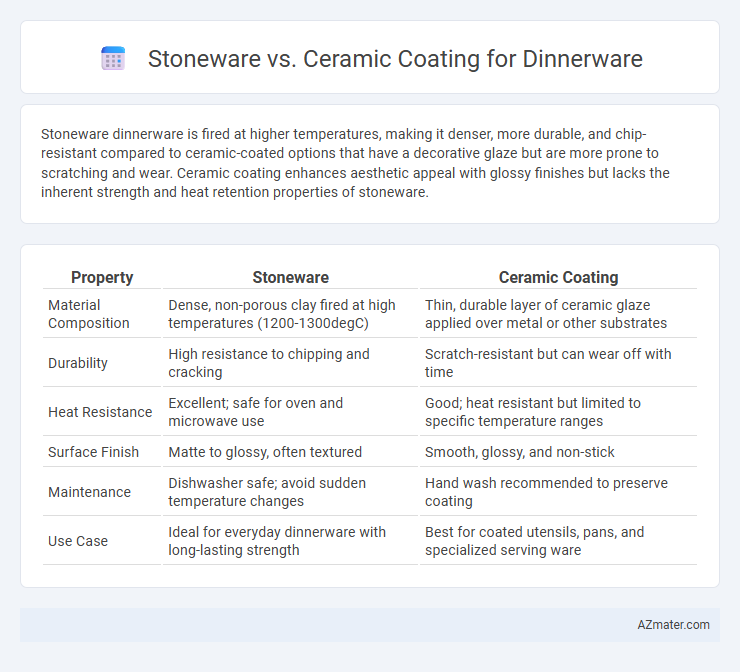Stoneware dinnerware is fired at higher temperatures, making it denser, more durable, and chip-resistant compared to ceramic-coated options that have a decorative glaze but are more prone to scratching and wear. Ceramic coating enhances aesthetic appeal with glossy finishes but lacks the inherent strength and heat retention properties of stoneware.
Table of Comparison
| Property | Stoneware | Ceramic Coating |
|---|---|---|
| Material Composition | Dense, non-porous clay fired at high temperatures (1200-1300degC) | Thin, durable layer of ceramic glaze applied over metal or other substrates |
| Durability | High resistance to chipping and cracking | Scratch-resistant but can wear off with time |
| Heat Resistance | Excellent; safe for oven and microwave use | Good; heat resistant but limited to specific temperature ranges |
| Surface Finish | Matte to glossy, often textured | Smooth, glossy, and non-stick |
| Maintenance | Dishwasher safe; avoid sudden temperature changes | Hand wash recommended to preserve coating |
| Use Case | Ideal for everyday dinnerware with long-lasting strength | Best for coated utensils, pans, and specialized serving ware |
Introduction to Stoneware and Ceramic Coatings
Stoneware dinnerware is made from dense clay fired at high temperatures, resulting in durable, chip-resistant pieces with a naturally textured surface. Ceramic coatings on dinnerware provide a smooth, non-porous finish that enhances stain resistance and makes cleaning easier while maintaining a glossy, elegant appearance. Stoneware offers rustic, earthy aesthetics, whereas ceramic coatings contribute to a polished look and added surface protection.
Material Composition and Manufacturing Process
Stoneware dinnerware is crafted from dense clay fired at high temperatures around 1,200degC to 1,300degC, resulting in a durable, non-porous material with natural earthy tones. Ceramic coating, often applied as a glaze on porcelain or earthenware, is composed of silica, fluxes, and metal oxides that melt during firing to create a smooth, often decorative, and protective surface. The manufacturing process for stoneware emphasizes vitrification through extended firing, whereas ceramic coatings rely on precise glaze formulation and controlled kiln environments to achieve desired texture and appearance.
Durability and Strength Comparison
Stoneware dinnerware offers superior durability due to its dense, non-porous structure, making it resistant to chipping and cracking under everyday use. Ceramic coatings on dinnerware provide a smooth, protective layer that enhances scratch resistance but may be more prone to wear over time compared to stoneware's natural strength. Overall, stoneware's robust composition ensures longer-lasting resilience, while ceramic coatings add a layer of aesthetic protection without significantly increasing structural strength.
Heat Resistance and Microwave Safety
Stoneware dinnerware offers superior heat resistance, withstanding temperatures up to 2,300degF, making it ideal for oven use and high-heat cooking. Ceramic coatings provide a smooth, glass-like surface that enhances microwave safety, as they are non-metallic and do not cause sparks or damage. Both materials ensure safe microwave use, but stoneware's durability excels in direct heat exposure, while ceramic coatings prioritize ease of cleaning and aesthetic appeal.
Aesthetic Appeal and Design Options
Stoneware dinnerware offers a rustic, handcrafted aesthetic with organic textures and earthy tones that enhance casual and farmhouse-style table settings. Ceramic coating on dinnerware provides a smooth, glossy finish with vibrant color options and intricate patterns, allowing for versatile and modern designs. Both materials support diverse design possibilities, but ceramic coating excels in achieving bright, refined aesthetics while stoneware emphasizes natural beauty and durability.
Non-stick Properties and Ease of Cleaning
Stoneware dinnerware features a dense, non-porous surface that offers moderate non-stick properties, making it relatively easy to clean with minimal residue. Ceramic coatings, especially those with a high-gloss finish, enhance non-stick capabilities by creating a smooth, inert surface that resists food adhesion and simplifies washing. Both materials provide durable options, but ceramic coatings typically require less effort for stain removal and maintain their ease of cleaning longer under frequent use.
Safety and Food-Grade Standards
Stoneware dinnerware is fired at high temperatures, making it non-porous, highly durable, and safe for everyday use with minimal risk of leaching harmful substances. Ceramic coatings on dinnerware, when formulated with food-grade, lead-free materials, provide a smooth, non-toxic surface that meets FDA and EU food safety standards. Both stoneware and properly coated ceramic products offer excellent safety profiles, ensuring no hazardous chemicals contaminate food during serving or consumption.
Environmental Impact and Sustainability
Stoneware dinnerware, made from natural clay fired at high temperatures, offers excellent durability and biodegradability, reducing landfill waste compared to synthetic materials. Ceramic coatings, often containing chemical additives or glazes, can involve higher energy consumption and potential release of toxins during production, affecting overall sustainability. Choosing unglazed or low-VOC ceramic coatings and locally sourced stoneware can significantly minimize environmental impact and promote eco-friendly dining options.
Pricing and Value for Money
Stoneware dinnerware typically offers higher durability and a rustic aesthetic at a moderate price point, providing excellent value for everyday use due to its resistance to chips and heat. Ceramic coating on dinnerware, often featuring intricate designs and a glossy finish, tends to be more affordable but may require delicate handling to avoid scratching or chipping, impacting long-term value. Choosing between stoneware and ceramic coating involves balancing initial cost with longevity, where stoneware often delivers better return on investment through sustained durability.
Choosing the Best Option for Your Needs
Stoneware offers durability and a rustic aesthetic, making it ideal for everyday use and casual dining, while ceramic coatings provide a smooth, often glossy finish that resists stains and scratches, perfect for more formal settings. Consider the heat resistance, maintenance requirements, and design preferences when selecting between stoneware's robustness and ceramic coating's decorative appeal. Stoneware typically handles high temperatures well, suitable for oven use, whereas ceramic-coated dinnerware emphasizes ease of cleaning and vibrant finishes.

Infographic: Stoneware vs Ceramic coating for Dinnerware
 azmater.com
azmater.com